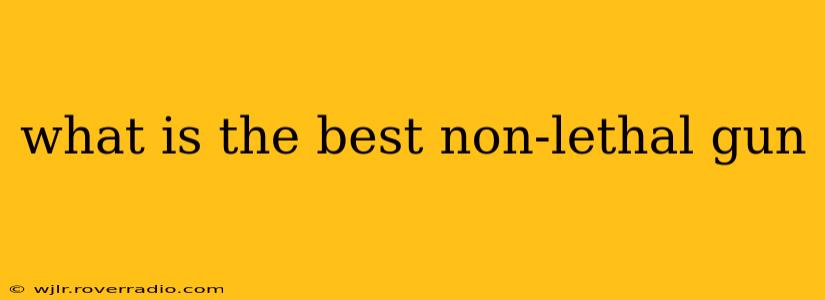What is the Best Non-Lethal Gun? The Complex Answer
There's no single "best" non-lethal gun, as the ideal choice depends heavily on the specific situation, user training, and legal considerations. The effectiveness of any non-lethal weapon relies significantly on proper training and responsible use. What might work for a trained law enforcement officer might be wholly inappropriate or ineffective for a civilian. Let's explore some of the most common options and their limitations:
What are the Different Types of Non-Lethal Guns?
Several technologies offer non-lethal incapacitation, each with its own strengths and weaknesses:
-
Pepper Spray Guns: These deliver a concentrated stream of oleoresin capsicum (OC) spray, a powerful irritant that causes temporary blindness, burning sensations, and respiratory distress. They are relatively inexpensive, easy to use, and legally accessible in many jurisdictions (with restrictions). However, their effectiveness varies based on wind conditions and the target's reaction. They are also less effective against individuals under the influence of drugs or alcohol, or those with a high pain tolerance.
-
Tasers (Stun Guns): Tasers use compressed air to fire two barbed probes that deliver a high-voltage, low-amperage electrical shock. This causes neuromuscular incapacitation, temporarily disabling the subject. Tasers are more effective than pepper spray in many situations, but require a direct hit and can be ineffective against thick clothing. Their legality and permitted use vary significantly by location. Moreover, there are concerns surrounding potential health risks associated with Taser use, especially for individuals with pre-existing heart conditions.
-
Bean Bag Guns: These launch small projectiles filled with lead shot or other materials. The goal is to cause blunt trauma, incapacitating the target without causing fatal injuries. Bean bag guns are generally more powerful than pepper spray or Tasers but still carry a risk of serious injury or even death if misused or used at close range. Accuracy is also crucial for effective deployment.
-
Rubber Bullet Guns: Similar to bean bag guns, these fire projectiles designed to cause blunt force trauma. However, rubber bullets are significantly harder and capable of causing more severe injuries, including broken bones and internal bleeding. They should only be used by trained professionals in situations where lethal force is not justified but significant incapacitation is required. Their use is highly regulated and not usually available to civilians.
What are the Legal Considerations for Owning a Non-Lethal Gun?
Laws regarding the ownership and use of non-lethal weapons vary significantly by location. Some jurisdictions strictly regulate or prohibit certain types of non-lethal weapons, while others have more lenient regulations. Before purchasing any non-lethal weapon, it is crucial to understand the local laws and regulations in your area. Improper use can lead to serious legal consequences.
What is the Best Non-Lethal Gun for Self-Defense?
Choosing the "best" self-defense tool depends entirely on individual circumstances, training, and local laws. A pepper spray gun might be suitable for some individuals, while others might prefer a Taser, if legally permitted. Crucially, effective self-defense requires proper training in the use and limitations of any chosen weapon. This includes understanding the legal ramifications of using any force, lethal or non-lethal. It is strongly recommended to consult with a qualified self-defense instructor and legal professional before acquiring and using any self-defense tool.
What are the Limitations of Non-Lethal Weapons?
It's vital to remember that no non-lethal weapon is foolproof. Their effectiveness depends on a multitude of factors, including distance, the target's physical condition and mental state, and environmental conditions. They also carry the potential for causing serious injury or death if misused, or if the target has an unexpected reaction. Non-lethal weapons are tools, not guarantees.
In conclusion, there is no universally "best" non-lethal gun. The optimal choice necessitates careful consideration of legal restrictions, personal training, and a realistic understanding of the limitations inherent in any non-lethal technology. Responsible ownership and training are paramount.
